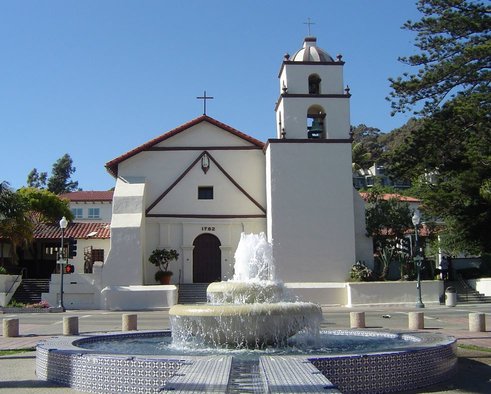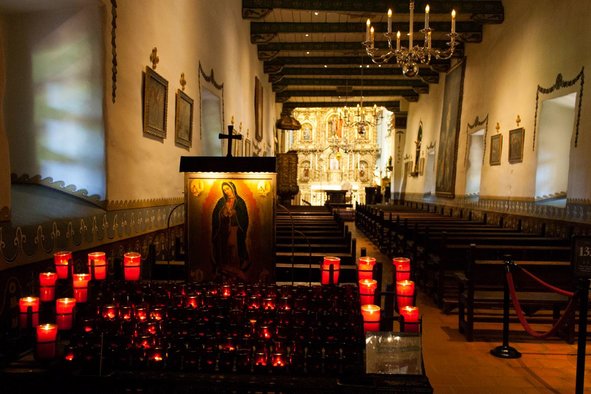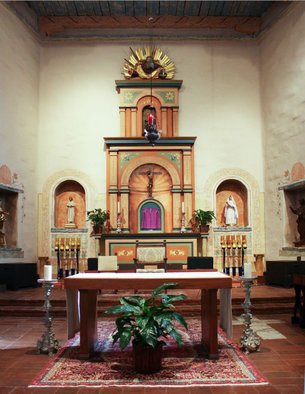Blessed Junípero Serra: Bringing the Faith to California
Visit Missions Founded by the Soon-to-Be Canonized Missionary on His Feast Day

“We found on our journey, as well as in the place where we stopped, that they treated us with as much confidence and goodwill as if they had known us all their lives,” once wrote Blessed Junípero Serra, California’s famous Franciscan missionary priest, of his travels.
Pope Francis will canonize Blessed Junípero Serra (1713-84) when he visits the United States this fall.
Blessed Junípero was from the Spanish island possession of Majorca, in the Mediterranean Sea, and traveled across the Atlantic Ocean to evangelize the native peoples of Mexico and California.
He established the first nine of California’s 21 missions: San Diego, San Carlos Borromeo (Carmel), San Antonio (Jolon), San Gabriel, San Luis Obispo, San Francisco (Mission Dolores), San Juan Capistrano, Santa Clara and San Buenaventura. The missions were used to teach American Indians the Catholic faith and learn new skills, such as growing crops and raising livestock, that would help improve their standard of living.
The California missions draw many visitors every year; most are active parishes with regular Masses, which function on or alongside historic grounds. Some are well preserved with many original buildings, while others only have remnants of their heydays 200 years ago.
A visit would be timely for his July 1 feast day.
Mission San Buenaventura (SanBuenaventuraMission.org) was the ninth and final mission founded by Father Serra — and one of six he personally dedicated in 1782. It is located in present-day Ventura, near Santa Barbara, and served the Chumash Indians of the region.
“It is my pleasure to be the 30th successor to Junípero Serra,” said Father Tom Elewault, the mission’s pastor.
The parish’s nickname, he said, is “Mission by the Sea,” not only because of its location one-eighth of a mile from the Pacific Ocean, “but because, by city ordinance, nothing can be built between the mission and the beach. It gives us a great ocean view.”

Highlights include the historic chapel, completed in 1809 and appearing much as it did 200 years ago. Its Stations of the Cross were painted in Spain and predate the mission by 40 years. A painting of Our Lady of Guadalupe near the sanctuary dates to 1747, and a large crucifix opposite it is from the Philippines, a former Spanish possession, and is believed to be several hundred years old. (Visit the website for a 360-degree tour of the chapel.) The mission museum has a large collection of Indian baskets.
Father Elewault describes Father Serra as “the evangelizer who first brought the Gospel to California.” He is pleased by the Holy Father’s decision to name him a saint, but noted the controversy around it, “because the European diet and disease decimated the Indian population. But that was not the missionaries’ purpose, but a sad by-product.”
He continued, “Serra saw himself as a spiritual father of the Native Americans of California and defended them.”
Mission San Juan Capistrano (MissionSJC.com) is the seventh of Serra’s missions, founded in 1776. It is among the best maintained of the California missions and has many of its original adobe buildings. It served the Juaneño Indians and is about an hour’s drive south of Los Angeles.

Its notable features include Serra Chapel, in which Blessed Junípero himself once celebrated Mass. It was built immediately after the founding of the mission, making it the state’s oldest church and one of its oldest buildings. Its interior includes a golden retablo (altar piece) and centuries-old artwork. The grounds also include the ruins of the “Great Stone Church,” a 200-year-old cruciform church that collapsed in an earthquake not long after its building. Visitors will also find an adobe soldier’s barracks and a line of adobe rooms that housed a mission kitchen, dining room and living quarters. Other sites include well-maintained gardens, fountains and an original cemetery.
“I’ve visited at least a dozen of the California missions, and it’s the best preserved that I’ve seen,” said docent Bob Spidell.
Father Serra was a determined man, Spidell said, driven to found the state’s missions so his priests could share the Gospel of Christ. He speculates that, without Serra, the state would have been colonized by English Protestants and its history much different: “The Spanish really had no one else like Serra. He had the vision, intellect and ability to found the California missions and make them a success.”
Mission Santa Clara (http://www.scu.edu/mission/), the eighth mission Serra founded in 1777, has no original buildings left. Its oldest structure was built in 1928. It is today a functioning parish located on the grounds of the Jesuit-run Santa Clara University (near San Jose).
Bob Senkewicz, a history professor at Santa Clara University, leads tours of the historic grounds. He shows visitors the quadrangle on which the historic mission was built, artwork that has survived and old photos of the mission grounds. He said, “I want visitors to understand that there was a lot of activity on the mission grounds and that it functioned as a working community.”
Senkewicz and Rose Marie Beebe have released a new book, Junípero Serra: California, Indians and the Transformation of a Missionary. When he leads tours, Senkewicz often assists visitors who are mistaken in their understanding of mission life. The missionaries, he concedes, were “human beings like you and I” and had their weaknesses, but the missions “were not set up to exploit Indians, but to protect them.”
Mission San Diego (MissionSanDiego.com) has the distinction of being California’s first mission, established in 1769 to serve the Kumeyaay Indians. Problems with the water supply and a desire to put distance between the mission and a presidio of Spanish soldiers led to it being moved six miles away in 1774, according to docent Tony Falon.
Highlights include the chapel, portions of which date to the 1770s, and historic artwork, including a 1770s’ painting of St. Didacus (San Diego in Spanish), for whom the mission is named. An Indian uprising in 1775 resulted in the murder of a padre, Father Luís Jayme; his gravesite can be found in the chapel.

Falon is excited about Serra’s canonization: “It’s good news for those of us who work and volunteer at the missions. We do it because we enjoy it, but we also take very seriously our role in sharing California’s mission history.”
Jim Graves writes from Newport Beach, California.
He served as a docent at Mission San Juan Capistrano,
the seventh of Father Serra’s missions.

















